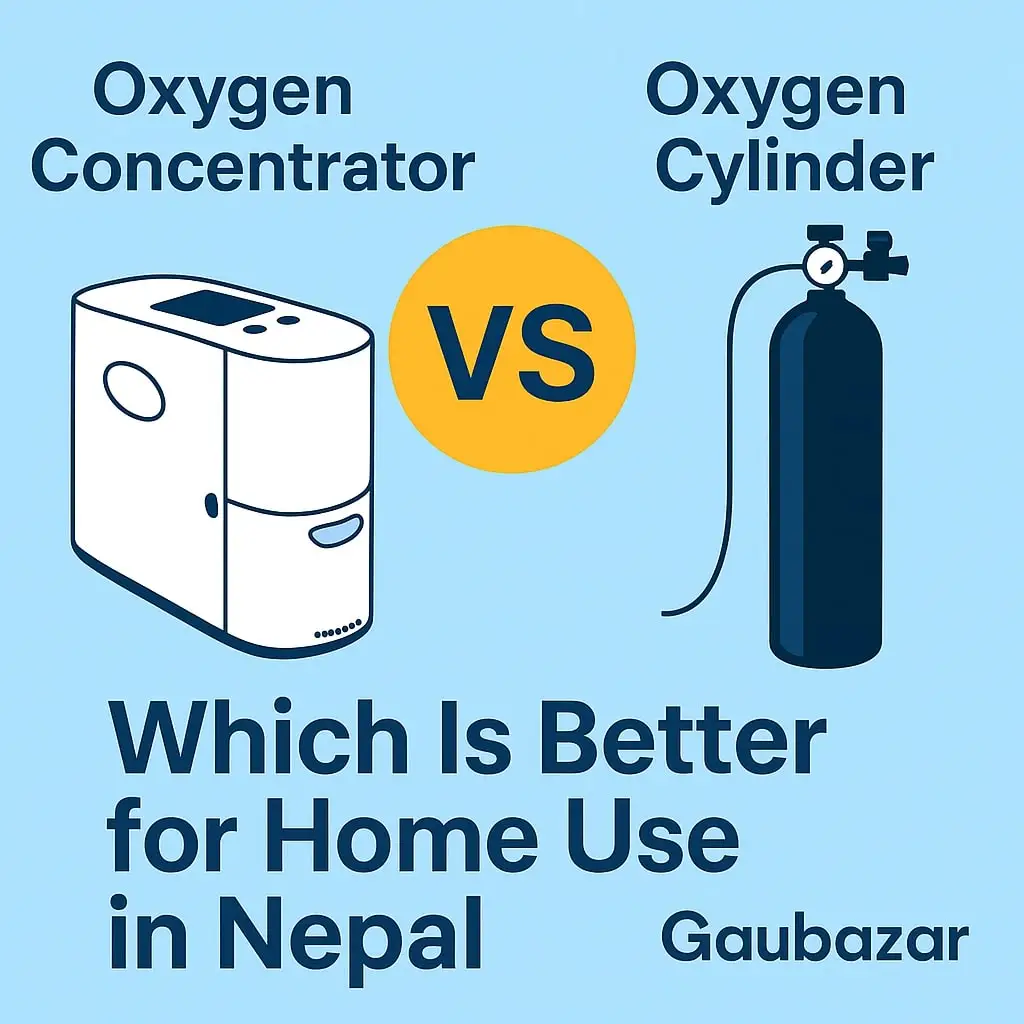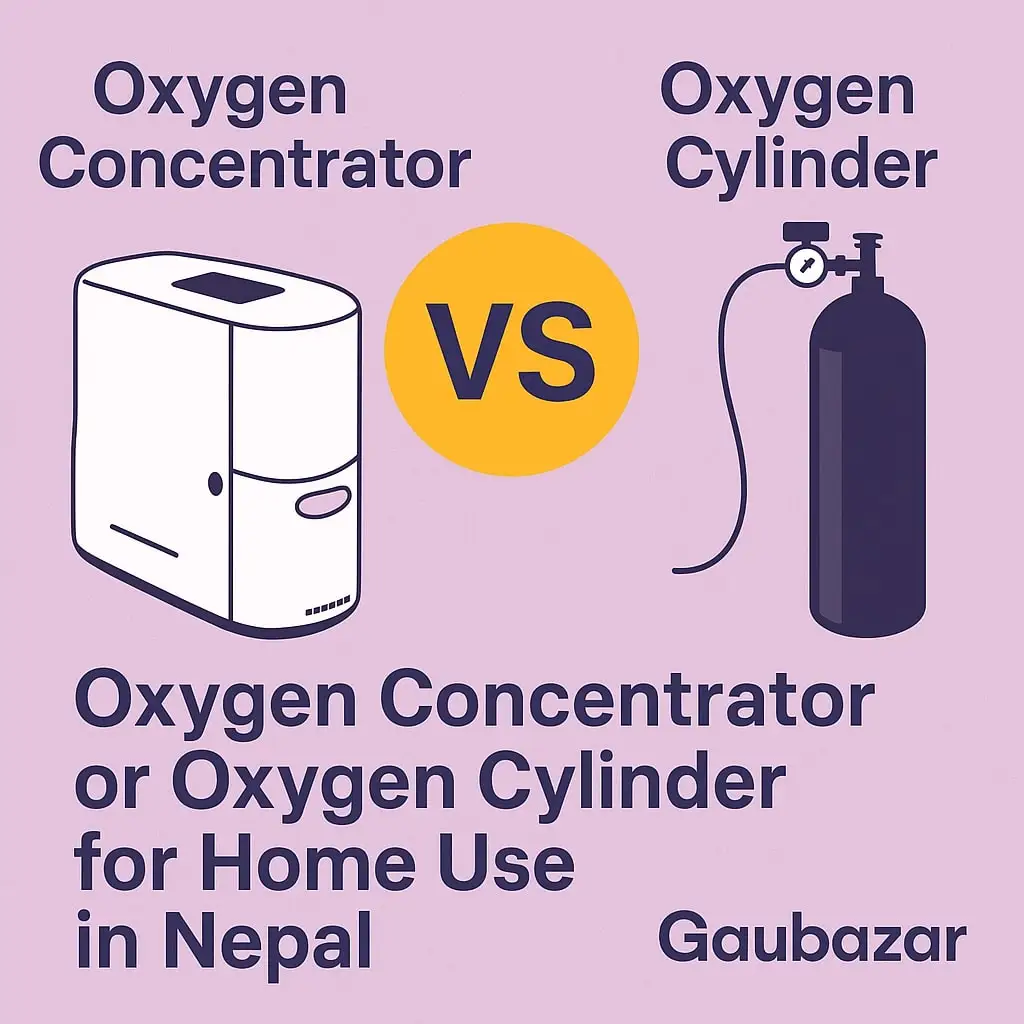
Access to reliable oxygen therapy has become a growing healthcare need in Nepal. Whether for patients with chronic breathing conditions, elderly care, or post-COVID recovery, many Nepali households now keep oxygen equipment at home.
But a common question arises — should you choose an oxygen concentrator or an oxygen cylinder?
As a health educator, I’ll help you understand the difference between these two life-saving tools and guide you to choose what’s best for your health, home, and safety.

🌬️ What Is an Oxygen Concentrator?
An oxygen concentrator is an electrically powered medical device that extracts oxygen from the surrounding air. It filters out nitrogen and delivers purified oxygen directly to the patient through a nasal cannula or mask.
Key Features:
- Works continuously as long as electricity is available
- Does not require refilling
- Provides consistent oxygen flow and purity
💡 In simple terms — a concentrator makes oxygen on demand.
Oxygen concentrators are becoming increasingly popular in Nepal because they’re cost-effective for long-term home use and easier to maintain than cylinders.
🧯 What Is an Oxygen Cylinder?
An oxygen cylinder is a metal tank prefilled with compressed medical oxygen gas. It releases oxygen through a regulator and flow meter. Cylinders are widely used in hospitals and ambulances and remain a reliable backup option.
Key Features:
- Does not require electricity
- Ready to use instantly
- Needs regular refilling once empty
💡 In simple terms — a cylinder stores oxygen that was already produced.
While oxygen cylinders are essential in emergencies or power outages, they can be heavy, less portable, and have ongoing refill costs.
⚖️ Oxygen Concentrator vs Cylinder: Key Differences
Feature | Oxygen Concentrator | Oxygen Cylinder |
|---|---|---|
Oxygen Source | Extracts oxygen from air | Pre-filled with oxygen gas |
Refilling | No refilling needed | Must be refilled regularly |
Power Requirement | Needs electricity | No electricity required |
Cost Over Time | Higher upfront, low maintenance | Lower upfront, high recurring cost |
Portability | Portable models available | Heavy and difficult to transport |
Safety | Lower fire/explosion risk | Requires careful handling |
Usage Duration | Continuous (unlimited air source) | Limited to tank capacity |
💡 For most Nepali families, oxygen concentrators are more practical for long-term therapy, while cylinders are useful as backup during power outages.
🏡 Which Option Is Better for Home Use in Nepal?
Both devices serve the same medical purpose — delivering oxygen — but the right choice depends on your specific needs and local conditions.
✅ Choose an Oxygen Concentrator If:
- You need long-term oxygen therapy (e.g., COPD, post-COVID, heart disease).
- You have stable electricity or a backup inverter.
- You prefer a one-time investment with low running costs.
- You want a clean and easy-to-use home oxygen source.
⚙️ Choose an Oxygen Cylinder If:
- You live in an area with frequent power cuts or unreliable voltage.
- You need emergency backup for hospitals or home use.
- You require oxygen only for short-term recovery.
Many Nepali homes today use both — a concentrator for regular therapy and a cylinder as a backup source for emergencies.
⚡ Challenges Faced in Nepal
🔋 Power Fluctuations
Electricity instability can affect concentrator performance. Use a voltage stabilizer or UPS to ensure consistent operation.
🌫️ Dust and Air Quality
Dusty environments (like Kathmandu Valley or Terai regions) can clog filters and reduce oxygen purity. Clean the air filter weekly.
🚗 Cylinder Refilling and Transport
In rural or hilly areas, oxygen cylinder refilling can be inconvenient or delayed. In such cases, a concentrator offers better reliability.
🧠 Safety Tips from a Health Educator
To ensure safety and effectiveness:
- Use oxygen equipment only under doctor supervision.
- Never smoke or light flames near oxygen devices.
- Keep concentrators in well-ventilated, dry areas.
- Regularly clean filters and replace cannulas.
- Have a backup plan (cylinder or portable concentrator) during outages.
💡 Safety and maintenance go hand in hand — proper use extends both the life of the device and the safety of the patient.

💸 Cost Comparison in Nepal
Equipment | Approx. Price Range | Long-Term Cost |
|---|---|---|
Oxygen Concentrator | NPR 65,000 – 160,000 | Minimal maintenance; no refills |
Oxygen Cylinder | NPR 15,000 – 30,000 | Ongoing refilling every few days/weeks |
While concentrators have a higher upfront price, their lifetime cost is significantly lower, making them more economical for long-term care.
🏥 Where to Buy Reliable Oxygen Concentrators in Nepal
For authentic and certified oxygen concentrator machines, always choose a trusted supplier.
GauBazar.com offers:
- Branded and certified oxygen concentrators
- Affordable prices and warranty options
- Home delivery across Nepal
- After-sales and service support
👉 Explore: Oxygen Concentrators for Sale in Nepal
💬 Final Thoughts from a Health Educator
When comparing oxygen concentrators vs oxygen cylinders in Nepal, remember:
- Both are vital tools for oxygen therapy.
- The best choice depends on usage duration, power availability, and convenience.
- For most Nepali homes, an oxygen concentrator is the better long-term solution — safe, economical, and sustainable.
At GauBazar, our goal is to support health awareness and access across Nepal. Whether you’re buying for a patient, clinic, or family member, we encourage informed choices for safer and healthier living.
